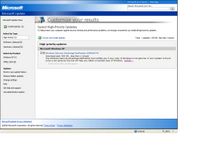Microsoft High Priority Patch!?
I've been tinkering with the IE7 beta 2 preview again and I have my homepage set to update.microsoft.com as an added measure to make sure that I'm always up-to-date on patches. I also use
Windows Update to automatically download and install patches. However, from time-to-time I find that I'm missing a patch that Windows Update missed.
Today Microsoft informed me of a "High Priority Update" that I'll be sure to install:
The Windows Genuine Advantage Notification tool notifies you if your copy of Windows is not genuine. If your system is found to be non-genuine, the tool will help you obtain a licensed copy of windows.
Gee, thanks Microsoft!
Actually, in all seriousness it is quite a good idea to use the a licensed copy of Windows these days because many of Microsoft's security features like Windows and
Office Update and the
Microsoft Security Baseline Analyzer require the validation check. I guess there isn't much difference between the validation check and installing this new "update" so I'm going to go ahead and put it on my desktop because if "virtually" licensed software some how gets installed in the future Microsoft will be able to tell how I can pay for it. :)

Big Surprise: Tim O'Reilly is not Evil
Tim O'Reilly has taken the time to
respond to the "owning web 2.0" controversy... and guess what... it turns out he has a reasonable explanation... that he does want to protect his brand of conference but isn't trying to claim ownership of web 2.0 in any other context. I agree with Tim's point that a polite/informal cease-and-desist request would have been a nicer first step but otherwise, I still can't see anything that he did wrong. Hopefully we can all get back to work now.
Flock Screws Up Blogger HTML?

I just wrote my post on the MS Word trojan using
Flock. I was kind of starting to like blogging with Flock but somehow posting with it seems to have screwed up the formatting of my blog. The sidebar with my profile, links and archives seems to have been replaced by part of my posting on SkypeOut/Vonage IPO post from earlier this week. I can do some extremely basic stuff with html, but I have no idea how to get formatting back to normal. I suppose I'll have to see it
Tom can help. This is very annoying... Argh!
technorati tags: Flock
Non-VC Buzz: Web 2.0 & TechCrunch Influence
After having written last week about VC's buzz surrounding Josh Kopleman's post that too many companies are building products solely for the TechCrunch / early-adopter audience, I've noticed that a number of the non-VC blogs I read have now also commented on the subject. However, I believe the whole meme still seems to under-estimate the value of this audience in two key ways:
- Early-adopters demonstrate market traction to friends&family and seed stage investors (but not Series A) that helps keep these startups afloat
- Early-adopters build out the user-generated content and community that so many web 2.0 startup rely on in order to add value to a wider audiences... think LinkedIn... mainstream corporate America is now starting to use this service but only because the network of 5M+ has existing value
Here is a summary of what continues to be an interesting conversation:
Matt Marshall suggests that the "53,651" buzz is itself newsworthy... and I agree :)
Dharmesh Shah advises that the TechCrunch landslide of user feedback is largely redundant and hard to manage. He further writes that "[startups are] much better off, where possible, trying to “stage” this adoption – to the degree [they] have control over it."
Om Malik argues that the mainstream will adopt web 2.0 technologies slowly and the tipping point is likely to be Yahoo, AOL and Microsoft incorporating them into their mainstream product launches. He also concludes that Web 2.0 may have its greatest impact on the enterprise where many of the scale issues that he claims plague web 2.0 companies with user bases greater than 300,000 users do not exist.
Dave Winer writes that size of user base only has relative importance if the startup is looking to make money and/or raise venture capital. He also suggests that VCs are not usually investors in very early technologies and therefore user base may not even be an indication of potential success for truly ground breaking companies. (I'd like to caution that I personally think this is very dangerous advice because very few companies really have ground-breaking technology that is simply too early for VCs to invest in w/o clear signs of market traction. Yet virtually every entrepreneur believes they have this type of ground-breaking technology. My three cents (ie more than anyone asked for) is that w/o market traction startups should remain hobbies rather than businesses because knowing when an entrepreneur should kill his/her own baby is always extremely difficult. People don't lose their homes because they decided to re-mortgage in support of their hobbies, yet this happens to entrepreneurs all too often. Delicious is a great example of a company that started as a hobby.)
Robert Scoble notes how far mainstream Americans are from web 2.0 commenting that he doesn't see ipods or any sign of web presence in advertising (ie urls) in his hometown. He suggests that widespread wifi, ala Google in Mountain View, and a more geek oriented culture may help diffuse web 2.0 to wider audiences.
If you missed it, don't forget to check out my summary of the last weeks VC buzz including Brad Feld, Charlie O'Donnell, Paul Kedrosky, Josh Kopelman, Jeff Nolan and David Beisel.
technorati tags: Web2.0, TechCrunch, 53,651, Early Adopters, Startups, Venture Capital











